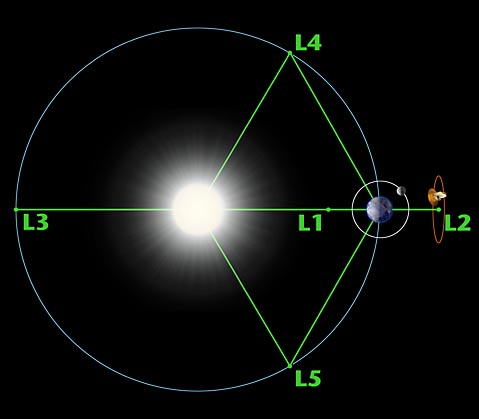Among the mitigation options for climate change are the so-called geoengineering projects, one of which is the placement in space of devices to deflect, block, or diffuse a small amount of the solar radiation hitting the Earth. This is one of the most straightforward of all the climate control technologies--if Earth is trapping too much heat or the Sun is getting too hot, just block a bit of it. No matter the cause of the increased average temperatures on Earth, this solution will reduce them. Moreover, even if future needs require additional solar radiation to maintain temperatures due to some cooling event, the same shades or reflectors might be quickly redesigned and used for that purpose as well--the beginning of a global climate control system.
How It Works No, there are not black spots in the sky or shady spots on the ground...

According to the design proposed by Roger Angel a series of thousands of thin semi-transparent shades would be placed in orbit around the sun at the Earth-Sun Lagrange point (L1, see diagram below)--a stable orbit constantly balanced between the Earth and Sun. Each of these shades would diffuse a small amount of the sunlight on the way from the Sun to the Earth thus reducing the total amount of sunlight striking the Earth.
There would be no shady spots on Earth, as most light would just pass through the shades. Even the solid opaque portions of the shade would be unlikely to cause dark shadows (umbra) due to the distance between them and the Earth. Viewing of sun spots and other solar phenomena would not be significantly impaired by the constellation of shades (imagine taking pictures through a chain length fence and focusing on something far beyond it--the fence practically disappears except for a slight fuzziness or brightness reduction in the picture). [ad name="Adsense Small Horz Banner"] Sunlight exerts a pressure on opaque or reflective surfaces (the reason why solar sails work) that can push the shades out of position over time, so the semi-transparent nature of the shade will limit this effect. Then, tiny reflective "fins" will orient themselves properly with respect to the Sun to maintain their proper position. The key to the shades is simplicity and light weight--both to reduce launch costs, and enable a robust networked system not dependent on the function of individual components to be successful.
How Much It Would Cost
Roger Angel proposes the development of electromagnetic rail guns to reduce the space launch costs to $20 per pound down from the current estimate of $10,000 per pound. Several rail guns would be required to launch payloads every 5 minutes continuously for 10 years. Total costs would be in the trillions of dollars. The development of the launch system alone would require a decade or two of serious engineering.

If these costs were averaged over the expected 50-year life of the shades, the average costs for controlling climate in this way would be on the order of $100-$200 billion per year for 50 years. Climate change impacts may last for 100-150 years, however, and the process may need to be repeated if newer technologies have not fully controlled the issue by that time.
These financing numbers are feasible with sufficient political will, however the extent of investment required for this one relatively straightforward solution should force reconsideration of other possible mitigation of these problems. Surface structure modification, complete transition to fully renewable energy, and other significant changes to current ways of doing business could all be implemented with the levels of financing required for this plan, many at much lower cost.
Potential Problems
Beyond the very high costs and the effort required to be maintained over generations to implement such a solution, there are other consequences of reducing the Earth's temperature by limiting solar heating. Chief among those concerns is that the solar shades, because they are so far from Earth, would each reduce the sunlight all over the planet by a small amount and result in significant climate shifts. Currently, because of distances and angles, more solar heating strikes the equatorial regions than the polar regions. After implementation of the solar shades, the temperature of the whole Earth would be slightly reduced, but the temperature of the equatorial regions would be reduced more, and the polar regions may experience warming--the temperatures across the whole planet would become more similar.
While this doesn't sound too bad, especially if you put stock in predictions of catastrophe if business as usual continues, there are substantial concerns to be dealt with even after spending the resources necessary to implement the solar shade system as this report from climate modelers points out:
"We found significant cooling of the Tropics, a warming of the polar regions and related sea ice reduction,” said Lunt. "We also found important differences in the hydrological cycle, with Sunshade World being generally drier than the pre-industrial ‘natural’ world. Average precipitation decreased by five percent with the largest decreases being in the Tropics."
Given the 25-year development and launch cycle combined with 50 years of maintenance, the persistence of society and government support required is enormous. Without catastrophic harm occurring on a regular basis, it is difficult to see how such support could be marshaled for such an endeavor. And, with catastrophic climate events occurring on a regular basis, it is difficult to imagine that adequate resources would be available.
